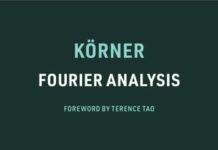
Ebook Info
- Published: 2003
- Number of pages: 590 pages
- Format: PDF
- File Size: 2.62 MB
- Authors: T. W. Korner
Description
Many students acquire knowledge of a large number of theorems and methods of calculus without being able to say how they work together. This book provides those students with the coherent account that they need. A Companion to Analysis explains the problems that must be resolved in order to procure a rigorous development of the calculus and shows the student how to deal with those problems.
Starting with the real line, the book moves on to finite-dimensional spaces and then to metric spaces. Readers who work through this text will be ready for courses such as measure theory, functional analysis, complex analysis, and differential geometry. Moreover, they will be well on the road that leads from mathematics student to mathematician.
With this book, well-known author Thomas Körner provides able and hard-working students a great text for independent study or for an advanced undergraduate or first-level graduate course. It includes many stimulating exercises. An appendix contains a large number of accessible but non-routine problems that will help students advance their knowledge and improve their technique.
User’s Reviews
Editorial Reviews: Review “This book not only provides a lot of solid information about real analysis, it also answers those questions which students want to ask but cannot figure how to formulate. To read this book is to spend time with one of the modern masters in the subject.” —- Steven G. Krantz, Washington University, St. Louis”T. W. Körner’s A Companion to Analysis is a welcome addition to the literature on undergraduate-level rigorous analysis. It is written with great care with regard to both mathematical correctness and pedagogical soundness. Körner shows good taste in deciding what to explain in detail and what to leave to the reader in the exercises scattered throughout the text. And the enormous collection of supplementary exercises in Appendix K, which comprises almost one-third of the whole book, is a valuable resource for both teachers and students. “One of the major assets of the book is Körner’s very personal writing style. By keeping his own engagement with the material continually in view, he invites the reader to a similarly high level of involvement. And the witty and erudite asides that are sprinkled throughout the book are a real pleasure.” —- Gerald Folland, University of Washington, Seattle”This is a remarkable book. It provides deep and invaluble insight into many parts of analysis, presented by an accomplished analysist. Korner covers all of the important aspects of an advanced calculus course along with a discussion of other interesting topics.” —- Paul Sally, University of Chicago
Reviews from Amazon users which were colected at the time this book was published on the website:
⭐This is a truly wonderful text in Analysis. I am unsure whether it would serve well as a primary text for a course in analysis, but it is by far the best out-of-class reference I have found for undergraduate analysis. Rudin is still the gold standard for a rigorous course in undergraduate analysis, but I honestly find Rudin completely unmotivated and for differentiation from R^m to R^n, I think Rudin is not as good as Korner. Contrary to what one of the other reviewers said, I find Korner’s Companion to be one of the few motivated, philosophically interesting, expansive resource in undergraduate analysis.This book has served me very well. While taking undergraduate analysis at MIT, we used Rudin and honestly it was a real effort to wrap my head around the elegance and generality of Rudin — that and Rudin has notoriously difficult problems. I eventually did come to grips with Baby Rudin and I’m glad for the stiff upbringing he gave me. However, after that first course, I found myself turning to Michael Barnsely’s “Analysis on Fractals” for some beautiful motivation and application of analysis. Finally appreciating the beauty of analysis, I went to Cambridge University, where Korner is a Professor, to undertake their second year tripos. Their analysis course includes a lot of differentiation from R^m to R^n, Contraction Mapping Theorem and Inverse and Implicit function theorems. The course was very much in the spirit of Korner’s book, and a lot of very difficult questions were asked and answered in exact detail.During that year, I found the book to be an excellent reference. The book contains many many worked examples and all sorts of crazy counterexamples in Analysis that you would not have normally considered. While reading this book you will often come across multiple re-tellings of the same theorem, with all the subtleties fully emphasized in the narration. I think that getting this wide treatment of so-called “common” results of analysis, with tweaked logical structure helps you appreciate the nuances of analysis.It should also be noted that in multivariable calculus/analysis, the “big D” notation can sometimes seem hopelessly disconnected from the crunch and grind of partial derivatives used in physics and methods courses. If you are interested in reading something where a professor addresses both uses and what information is supressed in each notation, I would recommend picking up this book and reading Appendix E.If you are one of those people either taking a first second course or second first course in analysis, and have all of these questions bubbling up about your newly formed mental model of analysis, this book will be longtime friend. You will no doubt be learning from a true master of Analysis.
⭐Korner says: “This book is intended for those students who might find rigorous analysis a treat.” Here are the usual terse treatments of the usual topics, and some not so usual. The dry recital of definitions, theorems and proofs could essentially have been pasted in from the usual analysis books (this book is certainly more mainstream than Korner’s other books), and it is all followed by something like a lifetime’s supply of exercises. However, this book is also of some value to those who don’t think of analysis as “a treat”, at least those who are opposed to the usual analysis course because of the dictatorial way in which it is typically taught. Korner complements the formal stuff with just the type of things that are missing in such an approach: informal discussions, historical background, context, motivation. Sometimes Korner seems almost human. These discussions are entertaining (before chapter 1 even starts, Korner has already quoted Plutarch, Barrow, Arnol’d, Churchill and Cauchy) and frequently also enlightening. But unfortunately these sections are very sparse. No need to buy the book; just spend an hour or two reading the good stuff in your library.
⭐After reading the introduction and several parts of the first chapter, I expected (and thought I had found) a book that had a genuinely new and interesting perspective on analysis. As I progressed further I was sorely disappointed. My experience with this book reflects my experience with many of the books published by the AMS in this series–they are neatly typeset and well-organized, the logic is impeccable, and they are completely devoid of interesting content, motivation, and direction.Although there is a precious gem here and there, most of this book is extremely mundane and simply runs through a very routine theorem-proof setup. The style of the book initially seems pleasant and explanatory but as you read further it becomes pedantic. The author sets you up to expect something new, and then there’s nothing new there. Perhaps this book would have been more pleasant if I had not already encountered most of the results in it–this book might be more enjoyable to a student who has taken only an introductory calculus course and no analysis.If I wanted a theorem-proof book I would pick the little Rudin, a book I don’t really like, but it’s not any worse than this one, and it’s a lot more concise. Any of the standard analysis and advanced calculus texts (Apostol, Taylor & Mann, Buck, etc.) are much better than this one. If you are looking for a book oriented towards self-study that actually offers a new perspective on analysis and a rich assortment of topics, consider Eric Schechter’s “Handbook of Analysis and its Foundations”. Not only does his book explore more related topics, but it also explores the logical foundations of analysis in much more depth.The worst thing about this book is how the author sets you up for such a disappointment by his grand little statement in the introduction…
Keywords
Free Download A Companion to Analysis: A Second First and First Second Course in Analysis (Graduate Studies in Mathematics) in PDF format
A Companion to Analysis: A Second First and First Second Course in Analysis (Graduate Studies in Mathematics) PDF Free Download
Download A Companion to Analysis: A Second First and First Second Course in Analysis (Graduate Studies in Mathematics) 2003 PDF Free
A Companion to Analysis: A Second First and First Second Course in Analysis (Graduate Studies in Mathematics) 2003 PDF Free Download
Download A Companion to Analysis: A Second First and First Second Course in Analysis (Graduate Studies in Mathematics) PDF
Free Download Ebook A Companion to Analysis: A Second First and First Second Course in Analysis (Graduate Studies in Mathematics)



